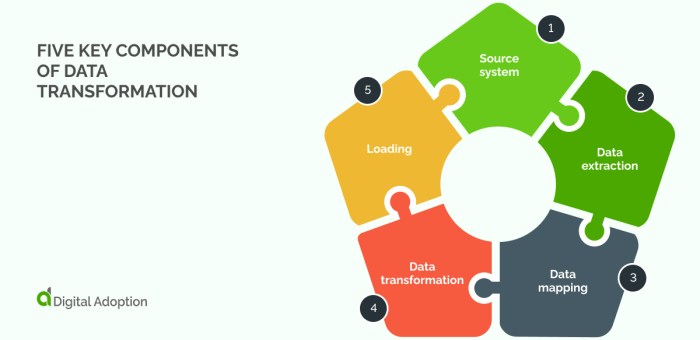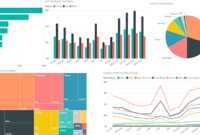Data transformation tools play a crucial role in modern data-driven environments, revolutionizing the way businesses process and utilize data. From data mapping to performance optimization, these tools are essential for efficient data management. Let’s delve into the world of data transformation tools and explore their impact on businesses.
Definition of Data Transformation Tools

Data transformation tools are software applications or platforms designed to convert, modify, and restructure data from one format to another. These tools play a crucial role in data processing by facilitating the extraction, transformation, and loading (ETL) process.
Primary Functions of Data Transformation Tools
Data transformation tools help businesses streamline and automate the process of data integration, migration, and transformation. They enable organizations to cleanse and enrich data, ensuring accuracy and consistency. Additionally, these tools support data mapping, validation, and normalization to ensure data quality and integrity.
- Facilitate ETL Process: Data transformation tools simplify the extraction, transformation, and loading of data from various sources into a unified format.
- Enhance Data Quality: These tools help in identifying and rectifying data inconsistencies, errors, and duplicates to improve data quality.
- Enable Data Mapping: Data transformation tools allow users to define relationships and mappings between different data sets for seamless integration.
Examples of Popular Data Transformation Tools
Some common data transformation tools used in industries include:
- Talend
- Informatica PowerCenter
- Microsoft SQL Server Integration Services (SSIS)
Importance of Data Transformation Tools in Modern Data-Driven Environments
In today’s data-driven environments, data transformation tools are essential for organizations to derive meaningful insights, make informed decisions, and drive business growth. These tools enable businesses to process vast amounts of data efficiently, ensuring data consistency, accuracy, and relevance for analytics and reporting purposes.
Types of Data Transformation Tools

Data transformation tools come in different types, each serving specific functions to help organizations manipulate and process data effectively. Let’s explore the key types of data transformation tools and their features.
ETL (Extract, Transform, Load) Tools vs. ELT (Extract, Load, Transform) Tools
ETL tools focus on extracting data from various sources, transforming it into a usable format, and then loading it into a target database or data warehouse. On the other hand, ELT tools extract data first, load it into a target system, and then perform transformations as needed. ETL tools are ideal for processing structured data, while ELT tools are better suited for handling unstructured or semi-structured data.
Batch Processing Tools for Data Transformation, Data transformation tools
Batch processing tools are designed to process large volumes of data in batches at scheduled intervals. These tools are efficient for handling complex transformations and data cleansing tasks. They allow organizations to process data in bulk, making them suitable for scenarios where real-time processing is not required.
Real-Time Data Processing Tools
Real-time data processing tools enable organizations to process data as it is generated, providing instant insights and actionable information. These tools are essential for time-sensitive operations and applications that require immediate data processing and analysis. Real-time data processing tools help organizations make quick decisions based on up-to-date information.
Open-Source vs. Commercial Data Transformation Tools
Open-source data transformation tools are freely available and provide flexibility for customization based on specific requirements. They are cost-effective options for organizations with limited budgets. On the other hand, commercial data transformation tools offer advanced features, technical support, and scalability for handling large volumes of data efficiently. Organizations with complex data processing needs often opt for commercial solutions to ensure reliability and performance.
Common Features and Functionalities
Data transformation tools come with a variety of key features and functionalities that enable users to efficiently manipulate and process data. These tools play a crucial role in ensuring that data is transformed accurately and effectively to meet business needs.
Data Mapping, Cleansing, and Integration
Data mapping allows users to define the relationships between different data sources, making it easier to transform and integrate data from various sources. Cleansing features help in identifying and correcting errors or inconsistencies in the data, ensuring its accuracy and reliability. Integration capabilities enable the seamless combination of data from multiple sources, enhancing the overall data transformation process.
- Data mapping facilitates the transformation of data by defining the connections between different datasets.
- Cleansing features help in identifying and rectifying errors, ensuring the accuracy and quality of the transformed data.
- Integration capabilities allow for the seamless merging of data from various sources, promoting a comprehensive data transformation process.
Handling Various Data Formats
Data transformation tools are equipped to handle a wide range of data formats, including structured, semi-structured, and unstructured data. These tools utilize advanced algorithms and techniques to parse and process data in different formats, ensuring that the transformation process is smooth and efficient.
- Structured data, such as databases and spreadsheets, can be easily transformed using data transformation tools through predefined rules and mappings.
- Semi-structured data, like XML and JSON files, can be processed using tools that offer flexibility in data manipulation and transformation.
- Unstructured data, such as text documents and multimedia files, can be transformed using tools that employ natural language processing and machine learning algorithms.
Role of Data Pipelines
Data pipelines play a crucial role in data transformation processes by automating the flow of data from source to destination. These pipelines enable the smooth and efficient transfer of data, ensuring that it is transformed and processed according to predefined rules and requirements.
- Data pipelines automate the movement of data through various stages of transformation, from extraction to loading.
- They help in orchestrating complex data transformation processes, ensuring that data is processed in a timely and efficient manner.
- Data pipelines enable the monitoring and management of data flow, providing insights into the transformation process and potential bottlenecks.
Importance of Scalability and Performance Optimization
Scalability and performance optimization are critical aspects of data transformation tools, especially when dealing with large volumes of data. These features ensure that the tools can handle increasing data loads efficiently and deliver results in a timely manner.
- Scalability allows data transformation tools to expand their processing capabilities to accommodate growing datasets without compromising performance.
- Performance optimization features help in enhancing the speed and efficiency of data transformation processes, minimizing processing times and improving overall productivity.
- Optimizing scalability and performance ensures that data transformation tools can meet the evolving needs of businesses and deliver reliable results consistently.
Implementation and Best Practices

Implementing data transformation tools in an organization requires careful planning and execution to ensure smooth integration and optimal performance. Here are some steps and best practices to follow:
Steps for Implementing Data Transformation Tools
- Assess Data Needs: Understand the specific data transformation requirements of your organization to determine the tools needed.
- Research and Select Tools: Explore different data transformation tools in the market and choose one that aligns with your business goals and technical capabilities.
- Plan Implementation Strategy: Develop a detailed implementation plan outlining timelines, resources, and responsibilities for deploying the chosen tool.
- Training and Onboarding: Provide training sessions for employees to familiarize them with the data transformation tool and ensure smooth onboarding.
- Testing and Quality Assurance: Conduct thorough testing to identify and rectify any issues before full deployment to ensure data quality and accuracy.
- Monitor and Evaluate: Continuously monitor the performance of the data transformation tool and evaluate its effectiveness in meeting organizational objectives.
Best Practices for Ensuring Data Quality and Accuracy
- Establish Data Governance: Implement data governance policies to maintain data quality standards and ensure consistency across all transformations.
- Data Validation: Use validation techniques to verify the accuracy and integrity of transformed data, reducing the risk of errors.
- Documentation: Maintain detailed documentation of data transformation processes, including transformations applied and outcomes achieved for future reference.
- Data Profiling: Conduct data profiling to analyze data quality issues and identify areas for improvement within the transformation process.
- Regular Audits: Conduct regular audits to assess the effectiveness of data transformation tools and identify any areas needing improvement.
Tips for Selecting the Right Data Transformation Tool
- Define Requirements: Clearly define your organization’s data transformation needs and objectives to identify the most suitable tool.
- Scalability: Choose a tool that can scale with your organization’s growth and handle increasing volumes of data efficiently.
- Integration Capabilities: Ensure the selected tool can seamlessly integrate with existing systems and technologies to avoid compatibility issues.
- User-Friendly Interface: Look for a tool with an intuitive interface that simplifies the data transformation process and requires minimal training.
- Vendor Support: Consider the level of support offered by the tool vendor, including training, technical assistance, and updates for long-term success.
Challenges and Solutions in Integrating Data Transformation Tools
- Legacy Systems Integration: Address compatibility issues when integrating data transformation tools with legacy systems by using connectors or APIs for seamless data flow.
- Data Security Concerns: Implement robust security measures to protect sensitive data during the transformation process and comply with data privacy regulations.
- Performance Optimization: Optimize the performance of data transformation tools by fine-tuning configurations, utilizing parallel processing, and optimizing resource allocation.
- Data Mapping Complexity: Simplify complex data mapping processes by using visualization tools and data mapping templates to streamline transformations and reduce errors.
In conclusion, data transformation tools are indispensable for businesses looking to enhance their data processing capabilities. By implementing best practices and selecting the right tools, organizations can streamline their data workflows and drive success in the digital age.
When it comes to business forecasting tools, companies need reliable solutions to make informed decisions. Utilizing the right Business forecasting tools can help organizations predict future trends and stay ahead of the competition.
Cloud data integration plays a crucial role in modern business operations. By implementing effective strategies for Cloud data integration , companies can streamline processes and enhance overall efficiency.
Real-time performance monitoring is essential for businesses to track their operations and identify areas for improvement. With Real-time performance monitoring tools, companies can make data-driven decisions in real-time.




